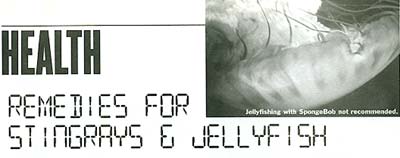SURFSHOT MAGAZINE, JUNE 2004 STINGRAY STINGS
There are over 1,500 reported stingray stings each year. They are very painful and can result in infection or even death. The Round Stingray (Urolophus halleri) is the most abundant species off the Southern California coast. What most commonly occurs when these creatures sting, what most commonly occurs is the poor stingray gets stepped on and pinned to the sand. The stingray then whips its tail up, plunging its stinger into whatever is on top of it. The stinger is a bony barb near the tip of its tail. When it's plunged into a surfer/swimmer, the glands of the barb pump venom into the wound causing a sharp, searing pain. The stinger can go right through your booties. Although the venom usually kills only the tissue surrounding the sting, if it were to be injected into a nerve, blood vessel or vital organ the effect could be deadly.TREAT A STINGRAY STING BY:
1. Deactivating the venom. This is possible because the venom is broken down by heat. The best thing to do is plunge your foot into hot water as soon as possible. Be careful not to burn yourself. If you have a thermometer handy, keep the water at around 112 degrees and soak for about an hour. Keep adding hot water to maintain temperature. DO NOT elevate the injured body part as this can cause venom to spread.
2. Care for the wound. Add a squirt of antibacterial solution or mild soap to the hot water. Once you're finished soaking, rinse the wound out with gallons of clean water. Sometimes pieces of barb come out. If the wound is large it may need stitches. If it's a small puncture wound, keep it open and allow it to drain. Soak in clean water two or three times a day. You may need antibiotics and a tetanus shot if you haven't had one in five years.
3. Manage the pain. Relieve the pain immediately by taking aspirin, Tylenol or ibuprofen. See a doctor if you need stronger medicine or if you're not back to normal after 36 hours.
JELLYFISH AND PORTUGUESE MAN OF WAR
The most common Jellyfish belongs to the Scyphozoans class of Cnidarians. They are made up of 99% water and can be found in all seas and some freshwater locations. Sizes range from 1 to 16 inches with some species reaching 6ft in width and 15ft in length. The Portuguese Man of War or Physalia physalis (in Greek means air bubble) is not a true Jellyfish, but belongs in the Hydrozoans class of Cnidarians. Their balloon-looking portion that is filled with carbon monoxide and floats on the water's surface most commonly identifies them. They can reach 50 feet in length in the open oceans.TREATMENT:
1. Do not rub the tentacles with your hands, a towel, sand, or clothing.
2. Spray or rinse the tentacles with. household VINEGAR for at least 30 seconds to prevent further stings.
3. If vinegar is not available, rinse the area with large amounts of salt water. Do not use fresh water; this may cause the tentacles to release venom (fire).
4. Rinse eye stings with a saline solution, such as Artificial Tears. Do not put vinegar, alcohol, or any other "stinger solution" in the eyes. The skin around the eye can be dabbed with a cloth saturated in vinegar, but you must be extremely careful not to get any of the solution in the eye.
5. If vinegar is not available, unseasoned meat tenderizer, baking soda, or household ammonia may be useful for treating jellyfish stings. Meat tenderizer or baking soda may be sprinkled directly onto the affected area or made into a paste by adding water and then applying to the skin. Household ammonia may be sprayed on or used to rinse the affected area.
6. If it is available, apply shaving cream or a paste of baking soda, flour, or talc to the tentacles. The tentacles will stick to the shaving cream or paste and can then be easily scraped off with a safety razor, a knife-edge, or the edge of a credit card.
7. Pick off tentacles with a stick or your hand protected by a towel or glove. Be very careful not to rub or press the tentacles.
8. Take an antihistamine, such as diphenhydramine or chlorpheniramine, or apply 1% hydrocortisone cream to help control itching.
9. Use an ice pack to help relieve pain.
10. Clean any open sores 3 times per day, apply an antiseptic ointment, such as bacitracin, and cover with a light bandage.In health and fitness,
Paul Frediani
www.surfflex.comSend us your surf health question to editor@surfshot.com and Paul will answer them. Selected questions will win a copy of this great book!


